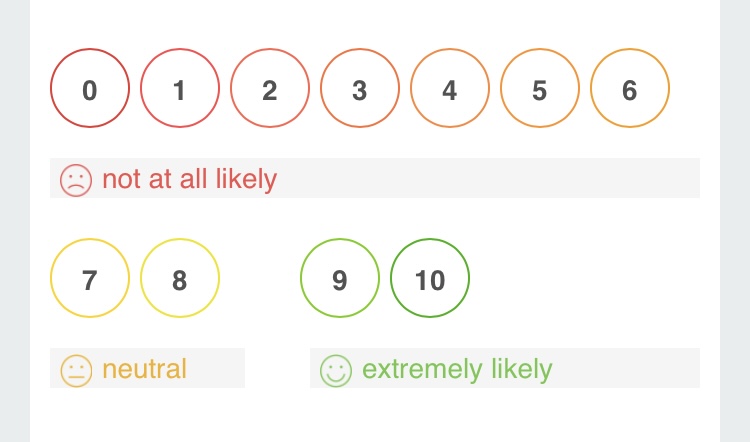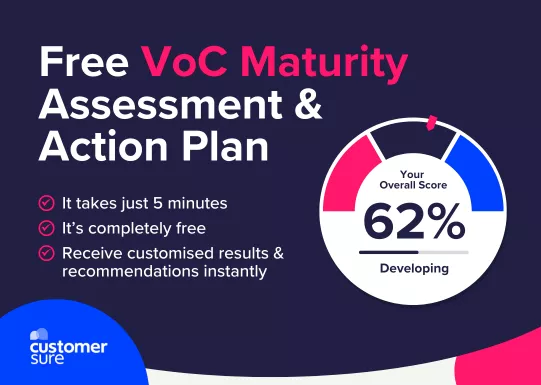

As readers of this blog know, I enjoy receiving invitations to leave my feedback , and having the opportunity to critique others’ surveys. There is a strange phenomenon I’ve seen a few times in recent months in customer satisfaction surveys, and some other people I follow on LinkedIn have made the same observation.
It’s the gaming of survey design to get better scores. And it seems to be happening more and more often.
A couple of weeks ago we had our washing machine repaired at home. After the repair I received an SMS invitation to complete a short satisfaction survey,sent by a leading washing machine manufacturer. The survey itself was fine, not too long and asked the right VoC questions to understand my experience.
The survey also asked the NPS question, but underneath the 0-10 scale, it provided a little key. Underneath 0-6 (which were all red), itsaid ‘Not at all likely’, 7-8 (which were yellow) it said ‘Neutral’, and 9-10 (which were green), it said ‘Extremely likely’. Now, you and I know the NPS question and how NPS is calculated, but the average man or woman on the street doesn’t. (And why would they?)

It’s clear that the company is gaming customer satisfaction survey design to get a better NPS score, by providing customers with this little key.
They feel the need to explain to customers that scoring a 6 means you definitely wouldn’t recommend them, andscoring an 8 means you probably wouldn’t recommend them either. I know how NPS is calculated, but why does this company (and countless others) feel the need to inform customers to try and nudge them further up the scale.
It ceases to be an impartial, reliable and robust measure of satisfaction, and becomes a gaming method to obtain higher scores. Reading other people’s experiences, there are even more blatant examples of gaming scores, such as employees telling the customer they need to give a 9 or a 10 if they think the service was ok, or giving a lower score would result in some punishment orpenalty for the employee. Using emotional blackmail to secure higher scores is a new low!
It got me thinking about why companies are doing this and what it is they want. There is a good chance that these companies have set targets and bonuses based on key metrics like NPS, and the priority to them is hitting their targets,not actually improving customer satisfaction.
Which is totally bizarre.
The reason for obtaining customer feedback and measuring satisfaction is toimprove the customer experience and thereby improve the success of thebusiness. It shouldn’t be a separate activity for hitting satisfaction targets so everyone can pat themselves on the back and pay bonuses. If someorganisations have satisfaction targets (although this is a really bad idea, see Goodhart’s law!) and hit them fairly and squarely, then fantastic, well done everyone.
But don’t set targets and then nudge / encourage / force your customers toprovide the scores you want. It makes the whole process pointless and untrue ifthe satisfaction scores go up but the commercial measures don’t.
The thing that annoys me most about this practice, is that the poor customer isthe one who loses out. Whilst the champagne corks are popping and the managersare patting themselves on the back for hitting their NPS target, a poorcustomer will be sat somewhere, thinking the service isn’t very good, stillwaiting for their issue to be resolved, and perhaps wondering why they scored a 9 when encouraged to do so, while their comments or requests go unanswered. Thecustomer is left thinking this company is not very good and doesn’t care.
I like to think there is some karma, and those same managers who congratulatedthemselves for hitting satisfaction targets, are left scratching their headsand are having to explain why they have lost customers to their competitors,whilst their NPS score is flying high.
The key point that people miss, remarkably, is that low scores are what help you find and fix problems and make customers more happy. The low scores, therefore,are the ones where the customer ends up happier and the company makes moremoney.
Don’t game your survey design and lead your customers. The only loser in the endwill be you.
Want to know more about sending out the most useful feedback surveys to improve your business? Get in touch with our team, and we can talk you through our customer satisfaction survey platform, and help you get the true and robust feedback to build your business on.

Gain a clear view of how mature your VoC programme is, and receive tailored recommendations to take it to the next level.
Take the assessment »